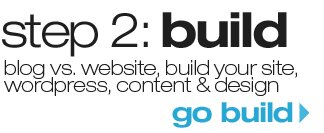So you want to learn how to make a website, but have little to no technical experience? Well read on!
1. Start now. Don’t feel like you need a complete understanding of every possibly technique before you get started making a website. Stop worrying about failure. If you get it wrong the first time, try again next month. The total start-up cost of registering a domain name and purchasing hosting shouldn’t cost anymore than $20. If $20 makes you uneasy, then you need to re-evaluate and take a hard look at what you’re spending money on.
2. Follow your interests. You will need to think of an topic or idea for your new website and the best way to get started is by creating websites based around subjects you are passionate about. Write down all your ideas, no matter who ridiculous they may seem. (see Finding a Topic or Niche)
3. Identify your audience. What kind of people will be reading your website? Brand. Build. Sell. targets people who want to learn more about how to make a website and who are not very tech savvy. Write down a targeted audience profile next to each website topic. This visitor profile should include ethnicity, age range, income level, occupation, religion, gender location and possibly level of education, internet surfing habits special interests and buying habits. (see Identify your Audience)
4. Research your keywords. If you want to build a successful money making website (or any type of website), you had better start paying attention to the words that appear on your website. The words that are appear over and over in your text may be the difference in how much money you make on the internet and if people are even able to find you. There are many free keyword tools available online, I like to use Google’s. (see Research your Keywords)

5. Determine your commitment. How much time and money do you want to invest into making a website? You can make a website for little to nothing or even make a free website, but amount of money you make is directly related to the amount of time you are willing to invest. If you don’t care about making money online, this skip this step. (see How Much Does This Cost? and How Long Does This Take?)
6. Types of websites. What type of site do you want to make? Content driven sites require a small initial investment, but will require you spend time writing keyword-rich information for your readers. To make money from this type of website, you will provide quality content and generate income from organic search engine traffic. (see Types of Websites)
E-commerce sites, sell products and will need more attention and maintenance. You will also need to think about shipping, processing orders, accepting payments online, inventory and everything a person with an offline storefront would have to manage. (see Selling and Collecting Payments)
Affiliate marketing is a low cost alternative to selling your own products. You will promote other people’s products for a commission.
7. Narrow down your list. Which ideas appear to be the most profitable? Which ideas look like they would be fun to work on? Which ideas require the most commitment? Making a website takes time, so choose the idea you are most passionate about (and will possibly make you some money).
8. Register a domain name and choose a web host. The best domain names are easy to remember and spell. To help with search engine optimization, your new domain should contain some of your main keywords. The best hosting and domain name register is Hostgator. They have an excellent customer service department, you can host an unlimited amount of websites, get unlimited bandwidth and you can get started with a 20% discount by using the code ‘SNOWMAN’.

9. Choose a website builder. For some new to the web I suggest WordPress, although there are many others to choose from. You can install WordPress in the control panel at Hostgator. Learning HTML or CSS coding isn’t the best way to spend your time. WordPress allows you to make a website by yourself and have you up and running in minutes. (see Other Website Builders)
10. Select a template. Templates can make your new website come alive and add a touch of personality. There are hundreds of sites online offering commercial template options, but since you want to minimize your initial cost, try out a free template. You can always upgrade your look after you have made some money. (see Free Templates)
11. Optimize your webpages. Making sure your pages can be easily crawled by search engines is essential to bringing in traffic. There are a few tips and tricks involved, that can be implemented into your website. (see Optimize your Webpages)
12. Test drive your website. When you have finally finished making your website, do usability testing. Send your website to family members and a few friends as ask them to complete specific tasks like, “order a product” or “download a file”. Ask them to send their results and you will likely find area where you need to improve navigation or clarify content.
13. Advertise. Contrary to what you have read elsewhere, do not submit your websites to major search engines. This is a unnecessary step and does not increase the chance of you site being crawled and indexed. The best way to get your site noticed is to get a link to it from another site, or link building. A few other ways to advertise is link exchanges and article marketing. (see Link Building and Bring the Traffic)
Tips for Making a Website
- Start small. Start simple. Even if whatever you create isn’t very impressive at the time don’t worry. Making a website is an ongoing process. Learn new techniques and try them out when you become more comfortable.
- The internet has made people impatient, so you only have between 10 – 30 seconds to capture your visitors attention. So to minimize your website loading time keep your graphics small and refrain from using flashy technology.
- If you are thinking of selling a product on your website, you will need to be able to accept secure credit card payments. You can apply for a merchant account, which charges a per-transaction fee, or use a free service like Paypal.
- Find popular websites closely related to your topic and use them as models. You can do this buy searching for your keywords in Google. Check out the first few sites listed in the results. What are they doing right? What are they doing wrong? Don’t just copy what they are doing learn from them by improving their process.
- Don’t be afraid to hire a professional. Just be aware that not everyone can do everything. All web designers aren’t web developers. Graphic design typically work in print media, but some are able to work on the web. A developer doesn’t usually know much about search engine optimization and getting your website to the top of Google. Try to find someone who specializes in your direct need or try to learn it yourself.
- Have real expectations. Set goals and check them every so often to make sure you are on track or determine if your goals need to be changed.






